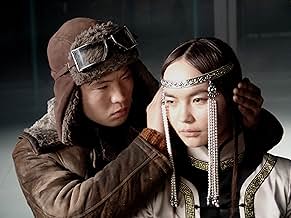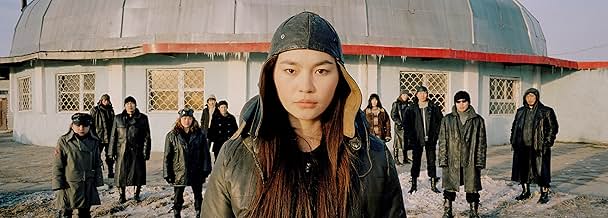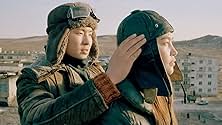Adicionar um enredo no seu idiomaSet in the frozen steppes of Mongolia, a young nomad confronted with his destiny after animals fall victim to a plague which threatens to eradicate nomadism.Set in the frozen steppes of Mongolia, a young nomad confronted with his destiny after animals fall victim to a plague which threatens to eradicate nomadism.Set in the frozen steppes of Mongolia, a young nomad confronted with his destiny after animals fall victim to a plague which threatens to eradicate nomadism.
- Direção
- Roteiristas
- Artistas
- Prêmios
- 16 vitórias e 5 indicações no total
- Direção
- Roteiristas
- Elenco e equipe completos
- Produção, bilheteria e muito mais no IMDbPro
Avaliações em destaque
This film is not meant for the audience that seeks light entertainment and action. It's a film of extreme visual beauty. Its aesthetics sometimes resemble one of Angelopoulos, with its long shots of great complexity. For those unfamiliar with the culture of Mongolia, this can be a great and refreshing experience. Main actors, who had no professional experience before this film, are so natural in their roles. Movies are about making people think and not lecturing them. This one is all about that: making you think. About the past, tradition, change of generations and what future is yet to bring. I highly recommend this film. It's a striking piece of art and a rewarding experience.
Introducing a young Tsetsegee Byamba wth great acting ability.
Magical realism, epilepsy, and the steppes of Mongolia.
A pilot dies. His son Bagi, who, like his father, has epilepsy, grows up on the steppes, herding sheep, subject to fits. A plague among the animals forces the family off their land to a city where Bagi gets a mining job.
His seizures become more frequent and bring visions in this wasteland of strip mining, factories, and rubble. He falls in with a troupe of student performers after saving the life of one of their number.
As the crisis of his people deepens - herders without flocks - Bagi uses the visions to seek direction. Can he save his people, and can he find love?
Magical realism, epilepsy, and the steppes of Mongolia.
A pilot dies. His son Bagi, who, like his father, has epilepsy, grows up on the steppes, herding sheep, subject to fits. A plague among the animals forces the family off their land to a city where Bagi gets a mining job.
His seizures become more frequent and bring visions in this wasteland of strip mining, factories, and rubble. He falls in with a troupe of student performers after saving the life of one of their number.
As the crisis of his people deepens - herders without flocks - Bagi uses the visions to seek direction. Can he save his people, and can he find love?
10mikellj
A true work of art. An emotional journey that captures the soul of Mongolian culture and tradition while posing important questions on the dilemma facing traditional Mongolian values by the destruction of Mongolians most precious treasure, their land, by international mining operations.
Beautifully crafted scene's and soul shaking audio design tell much of the story that has been left unverbalized. The directors have done an amazing job of researching Mongolian culture, society, social changes, etc. and show a true appreciation for Mongolia's heritage.
The directors use of a generally unexperienced cast, with the exception of a few of Mongolia's best, had astounding results. The actors who played the main characters Bagi and Zolzaya were flawless, especially considering they have never acted before.
Reading the synopsis and interviews with the directors afterwards may help some not familiar with Mongolia to better understand some of the deeper meaning and symbolism embedded in this film.
10 out of 10!
Beautifully crafted scene's and soul shaking audio design tell much of the story that has been left unverbalized. The directors have done an amazing job of researching Mongolian culture, society, social changes, etc. and show a true appreciation for Mongolia's heritage.
The directors use of a generally unexperienced cast, with the exception of a few of Mongolia's best, had astounding results. The actors who played the main characters Bagi and Zolzaya were flawless, especially considering they have never acted before.
Reading the synopsis and interviews with the directors afterwards may help some not familiar with Mongolia to better understand some of the deeper meaning and symbolism embedded in this film.
10 out of 10!
The reviewer of this film from Holland provides an excellent perspective of this film as an experiment in art. As an anthropologist familiar with Mongolian nomadic culture and the historical background of the horrible collectivizing results of the Maoist government of the PRC on the population of inner Mongolia where thousands died due to the heavy handed and incompetent Maoist policies, I can certainly relate to the subtext of the story of Khadak. As a film, the organization of the storyline leaves much to be desired and does have an amateurish feel to it. However, the portrait of the Mongol people in this film against the bleak background of the steppes where they've lived for centuries and the shoddy, bleak living complex and mining facility to where they've been relocated, is quite striking. The faces of the actors in long and short still shots adds to this effect. Personally, I find the Mongols to be a strikingly beautiful people with a unique history ranging from great conquest to severe abuse under both Chinese and Soviet hegemony. In this context, I find this little film to be quite good in spite of its shortcomings.
One of world cinema's biggest virtues is that it allows us to have a personal vision of distant places where it would be difficult for us to travel due to various reasons. Mongolia is one such remote area which has caught the attention of various film directors as many films have been set in this vast central Asian nation ever since it was popularized in 1989 by renowned German director Ms. Ulrike Ottinger through her film "Johanna D'Arc of Mongolia". Mongolia is honestly represented by ethnographic filmmakers Peter Brosens and Jessica Woodworth. Khadak is not a documentary film but it has made good use of a lot of documentary cinema's conventions to get closer to reality. Although the main story moves slowly, there are plenty of minor stories to keep in check the viewers' attention. These stories are an excellent initiation into the lives of people in Mongolia as each story represents an event related to the lives of the protagonists. One needs to watch this film if one's knowledge of ethnographic films is restricted uniquely to films made by Jean Rouch.
Você sabia?
- Erros de gravaçãoIn the shots where the Shamaness is smashing the liquor bottles on the ground, several of them bounce, or just break into a few pieces, but the sound effect is still that of a bottle shattering to bits.
- Trilhas sonorasMother Mongolia
Written by Altan Urag
Performed by Altan Urag
Principais escolhas
Faça login para avaliar e ver a lista de recomendações personalizadas
Detalhes
- Data de lançamento
- Países de origem
- Idioma
- Também conhecido como
- Suyun Rengi
- Locações de filme
- Empresas de produção
- Consulte mais créditos da empresa na IMDbPro
Bilheteria
- Orçamento
- € 3.000.000 (estimativa)
- Faturamento bruto nos EUA e Canadá
- US$ 3.139
- Fim de semana de estreia nos EUA e Canadá
- US$ 1.983
- 14 de out. de 2007
- Faturamento bruto mundial
- US$ 37.781
- Tempo de duração
- 1 h 44 min(104 min)
- Cor
- Mixagem de som
Contribua para esta página
Sugerir uma alteração ou adicionar conteúdo ausente









